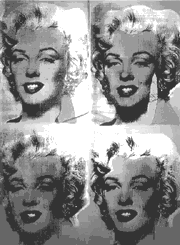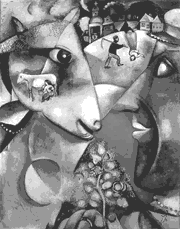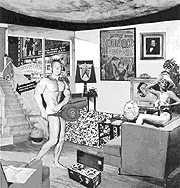| back to: syllabus 
Mona Lisa
Leonardo da Vinci
oil on wood panel
1503-1505 (Italian Renaissance)

Four Marilyns
Andy Warhol
>synthetic polymer and silkscreen ink on canvas
1962 (Pop Art)

The Dinner Party
Judy Chicago
painted porcelain and needlework
1974-79 (Feminist Post-modernism)

I and the Village
Marc Chagall
oil on canvas
1911 (Fantasy)

The Steerage
Alfred Stieglitz
photograph
1907

Nighthawks
Edward Hopper
oil on canvas
1942 (American Regionalism)

Just What Is It That Makes Today's Homes So Different, So Appealing
Richard Hamilton
collage
1956 (Pop Art)

Liberty Leading the People
(French Romanticism)
oil on canvas
1830
by Eugene Delacroix
|
Chapter 1: What is Art?
Definitions of art.
Merriam Webster: Main Entry: art
Pronunciation: ”rt
Function: noun
Etymology: Middle English, from Old French, from Latin art-, ars --
Date: 13th century
- : skill acquired by experience, study, or observation "the art of making friends"
plural : LIBERAL ARTS
b archaic : LEARNING, SCHOLARSHIP
- : an occupation requiring knowledge or skill "the art of organ building"
- a : the conscious use of skill and creative imagination especially in the production of aesthetic objects; also : works so produced
b (1) : FINE ARTS (2) : one of the fine arts (3) : a graphic art
- a archaic : a skillful plan b : the quality or state of being artful
- : decorative or illustrative elements in printed matter
synonyms ART, SKILL, CUNNING, ARTIFICE, CRAFT mean the faculty of executing well what one has devised. ART implies a personal, unanalyzable creative power . SKILL stresses technical knowledge and proficiency "the skill of a glassblower". CUNNING suggests ingenuity and subtlety in devising, inventing, or executing "a mystery plotted with great cunning". ARTIFICE suggests technical skill especially in imitating things in nature "believed realism in film could be achieved only by artifice". CRAFT may imply expertness in workmanship "the craft of a master goldsmith".
Additional Definition: a work of art differs from other similar objects because it exhibits greater than normal significance.
Introductory notations.
Images influence us and have for as long as art has existed
- The classroom we are sitting in was designed by those who understand how visual forms affect us.
- Colors such as blue or red have psychological influences on us. The color psychologist Faber Birren found that color affects us.
- Lines such as the vertical line of a column can influence the way we experience a place.
- Every man-made object or place has been designed with consideration made toward their visual form.
- We make aesthetic decisions every day to communicate characteristics of our personality.
-Assumptions about art: "Talent" and "should look like something" are simplifications.
-"I don't know much about art, but I know what I like." is not a reasonable art criticism.
-Aesthetics is a branch of philosophy that deals with visual form.
WHAT DOES ART DO?
- Art Creates Beauty
Although the Mona Lisa is often considered a painting of ideal beauty, in the time it was created it was regarded highly for its fantastic background (aerial perspective), illusion of solidity in the figure (chiaroscuro), and the fact that it was the only painting that Leonardo would not sell.
Orlan
- Art Enhances Our Environment
Galla Placidia
Dale Chihuly
- Art Reveals Truth
The artists of the DeStijl movement, a 20th Century art movement centered in the Netherlands, were one of many groups who worked to achieve "honesty" in their artwork. Many artists of the Modern movement saw the illusionary art of the past as dishonest. The goal of most European artwork had been to "fool" the viewer. But the DeStijl painters created works that did not show recognizable images or infer depth. A good example of this is Piet Mondrian's Composition in Red, Blue, and Yellow.
Two Fridas, by Frida Kahlo
- Art Immortalizes
Andy Warhol saw commercialization and marketing as art forms in themselves. He set up his studio to be like a factory (He called it the Art Factory)where he "manufactured" works just like any other product. He also realized that personalities were also products that could (and had) been marketed. He practiced his theories by marketing his own persona and those of other cultural icons like Marilyn Monroe and Elvis Presley.
- Art Expresses Religious Beliefs
Symbolism is important in almost all religious art. A great example of this occurs in Romanesque and Gothic churches of the late Middle Ages. For example, the plan of the Church of Ste. Foy at Conques in France shows us a symbol that cannot be seen from any other vantage point except for directly above. The massive dome of the Hagia Sophia creates a sense of awe because of its massiveness.
- Art Expresses Fantasy
Marc Chagall was a Russian-born French artist who used his work to recreate memories of his childhood. He often referred to his "storybook Russia" from which many of his images are derived.
- Art Stimulates the Intellect and Fires the Emotions
Buckminster Fuller invented the geodesic dome. This gave rise to engineering on a number of scales. Architects use a series of tetrahedrons to create a perfect sphere that is structurally sound (like Epcot Center at Disney World). Scientists now have invented a manufactured molecule called a "Buckyball" which is based on this use of tetrahedrons to create a perfect and exceptionally strong manufactured molecule.
- Art Creates Order and Harmony
The Greek mathematical ratio called the Golden Mean: The spiral of the nautilus shell decreases in size at a perfect 1:1.618 ratio. This ratio has been used by artists to create dynamic composition in artwork and architectural design since the time of the ancient Greeks.
- Art Expresses Chaos
- Art Records and Commemorates Experience
Ford Madox Brown, The Last of England
- Art Reflects the Social and Cultural Context
Edward Hopper and many of the American artists of the 1930's and 1940's were interested in creating an identity that would buoy the American spirit during those times war and hardship. Hopper was loosely associated with the American Regionalist art movement. A group of artists who were interested in reflecting the strength and character of America.
- Art Protests Injustice and Raises Social Consciousness
Guerrilla Girls
Liberty Leading the People by Eugene Delacroix is a Romanticist work that implied a need for spontaneous revolution that he thought should be supported by all the classes of 19th Century France.
- Art Elevates the Commonplace
- Art Meets the Needs of the Artist
Chapter 2
|
|
|
